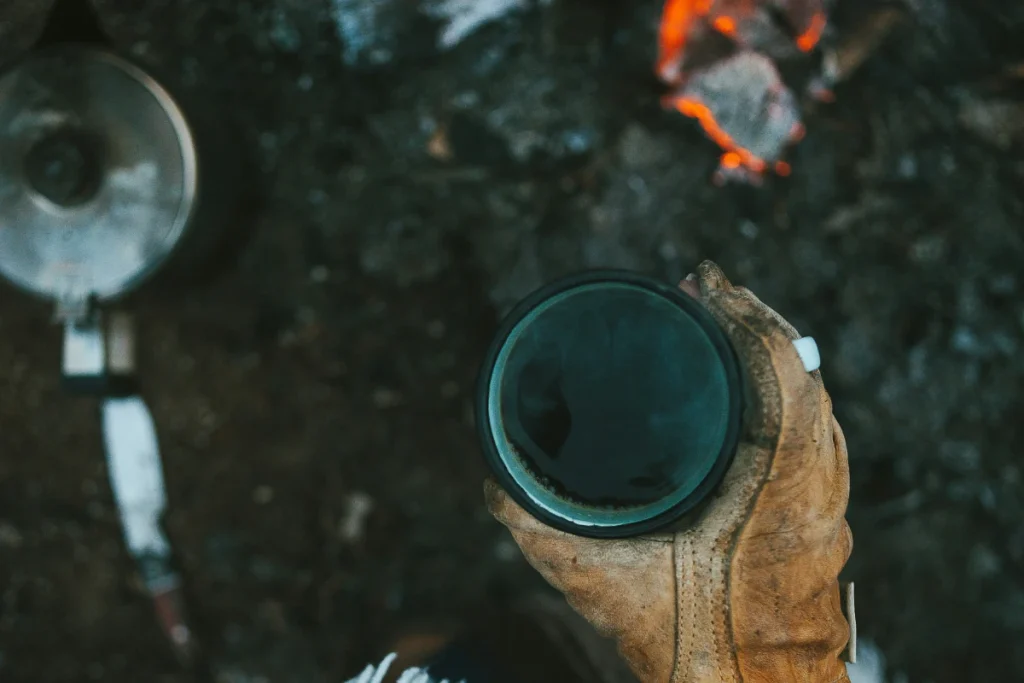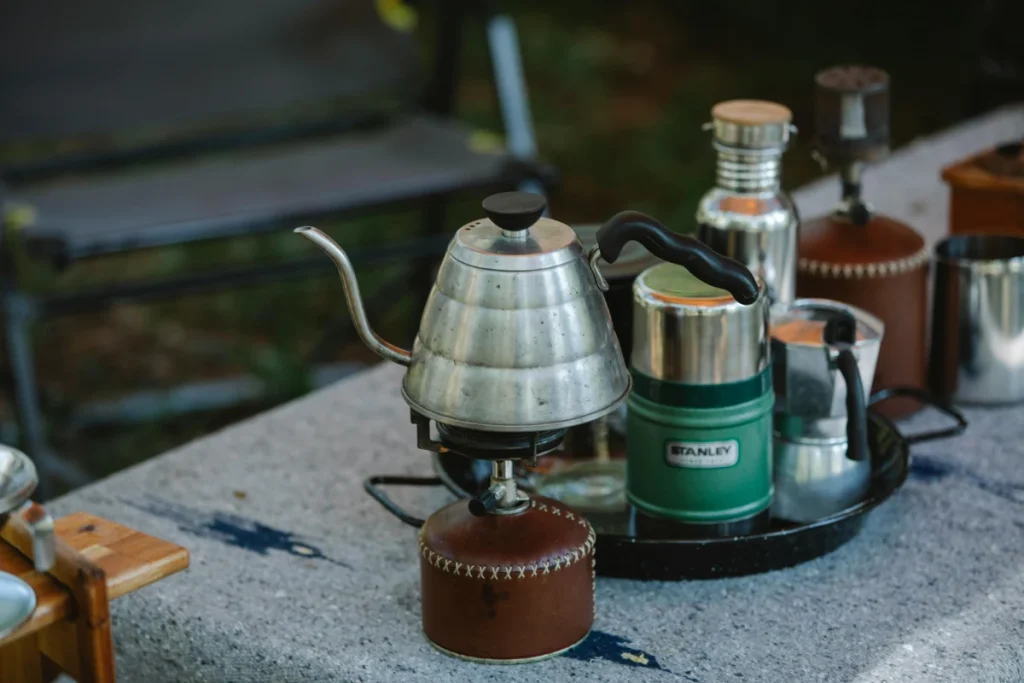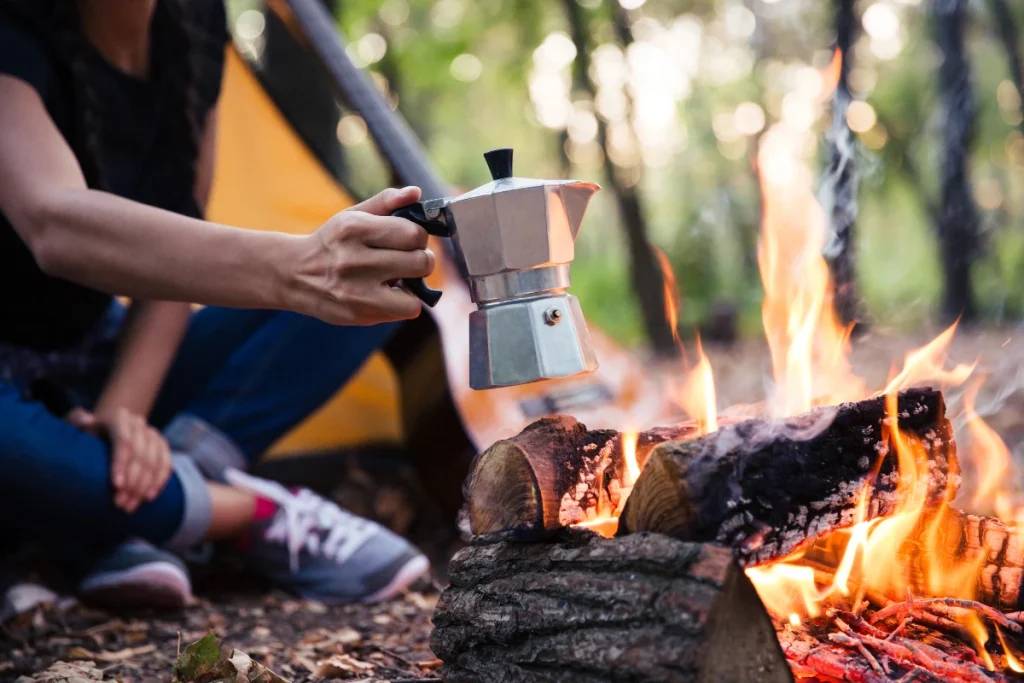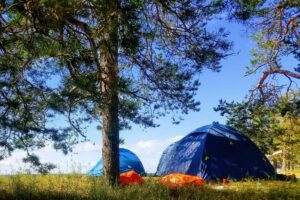How To Make Cowboy Coffee at Camp
Imagine waking up to the serene beauty of nature, the cool morning air, and the enticing aroma of freshly brewed coffee. That’s the charm of cowboy coffee, a staple for campers who love to start their day with a robust cup of joe. Now granted, I definitely prefer the simplicity of using an Aeropress for my camp coffee, but sometimes it make more sense to brew a pot if you with a few people. This post will guide you through the simple yet rewarding process of making cowboy coffee at the campsite, ensuring you enjoy every sip amidst nature.

What You’ll Need
To brew the perfect cowboy coffee, you need just a few basic items:
- Coffee grounds: Medium to coarse grind works best.
- A pot or kettle: Any campfire-friendly pot will do.
- Fresh water: The quality of water affects the taste.
- Heat source: A campfire or portable stove.
In the quest to brew the perfect cup of cowboy coffee, your choice of equipment and coffee grind plays a pivotal role. Below, we compare various coffee pots and coffee grinds to help you select the best options for your outdoor brewing adventure. Whether you prefer the rugged durability of a cast iron pot or the fine balance of a medium grind, understanding these differences will enhance your coffee experience in the great outdoors.

Coffee Pots Comparison
| Coffee Pot Type | Material | Heat Source | Durability | Taste Influence |
|---|---|---|---|---|
| Enamelware Coffee Pot | Steel with porcelain enamel coating | Open fires, camp stoves | Highly durable, can chip if dropped | Neutral, does not influence the coffee flavor |
| Stainless Steel Coffee Pot | Stainless steel | Compatible with all heat sources | Extremely durable and resistant to rust | Minimal influence, maintains coffee flavor |
| Cast Iron Coffee Pot | Cast iron | Ideal for campfires, not suitable for lightweight camping | Highly durable, requires seasoning to prevent rust | Can add a unique flavor over time |
| Moka Pot | Aluminum or stainless steel | Stovetop, portable camp stove or open flame (with caution) | Durable, aluminum pots require careful handling to prevent denting | Produces strong, espresso-like coffee |
Coffee Grinds Comparison
| Grind Type | Texture | Brewing Time | Ideal For |
|---|---|---|---|
| Coarse Grind | Similar to coarse sea salt | Longer due to larger grind size | Minimizing grounds in cup, easy settling |
| Medium Grind | Similar to sand | Balanced, versatile choice | Stronger flavor without excessive bitterness |
| Fine Grind | Finer than table salt | Faster extraction, shorter brewing time | Intense flavor and body, risk of grounds in coffee |
Step-by-Step Guide to Making Cowboy Coffee
- Boil Water: Start by bringing water to a boil in your pot over the campfire or stove.
- Add Coffee: Remove the pot from the heat and let it cool slightly. Then add your coffee grounds directly into the water.
- Stir and Steep: Give the mixture a good stir and let it steep for about 4 minutes. Adjust the time to suit your taste preference.
- Settle the Grounds: To settle the grounds, tap the pot gently or sprinkle a little cold water on the surface.
- Serve: Carefully pour the coffee into your cup, avoiding the settled grounds at the bottom of the pot.

Tips for the Perfect Brew
- Water Temperature: Letting the water cool for 30 seconds after boiling before adding coffee prevents over-extraction.
- Coffee-to-Water Ratio: A standard ratio is about 2 tablespoons of coffee per 8 ounces of water, but adjust to taste.
- Experiment: Try adding a pinch of salt or a dash of cinnamon for a unique flavor twist.
Enjoying Your Coffee in Nature
With your freshly brewed cowboy coffee in hand, take a moment to relish the experience. The rustic method of brewing, combined with the natural backdrop, creates a sensory delight. Sip your coffee as you watch the sunrise, listen to the birds, or simply enjoy the tranquility of the great outdoors.
Making cowboy coffee is more than just a means to a caffeinated end; it’s an integral part of the camping experience. It connects you to the simplicity and ruggedness of nature. Next time you’re out camping, embrace the tradition of cowboy coffee and make your morning brew an adventurous ritual.
Frequently Asked Questions
Cowboy coffee stands out due to its brewing technique and the context in which it’s made. Unlike regular coffee, which often relies on sophisticated brewing equipment, cowboy coffee is made with just a pot, water, coffee grounds, and a heat source, typically a campfire. The method involves boiling water with coffee grounds directly in the pot and allowing the grounds to settle before drinking. This rustic approach not only simplifies the brewing process but also adds a unique flavor profile influenced by the open fire and the great outdoors.
To minimize grounds in your cup, let the coffee sit for a minute after removing it from the heat source, allowing the grounds to settle at the bottom of the pot. Some outdoor enthusiasts recommend adding a small amount of cold water to expedite the settling process. Another tip is to tap the pot gently or swirl it, which helps the grounds settle faster. When pouring the coffee, do so slowly and steadily to prevent disturbing the settled grounds.
Yes, cowboy coffee is safe to drink, provided that you use clean water and ensure it reaches a boiling point during the brewing process. Boiling water is crucial as it kills most pathogens, making the coffee safe for consumption. However, if you’re using water from a natural source, it’s advisable to purify it before brewing to avoid any waterborne illnesses.
Proper cleanup is essential to leave no trace and protect the environment. Once you’ve finished your coffee, allow the pot to cool. Dispose of the grounds by storing them in a bin or container to pack them out with your trash. Clean the pot with a small amount of biodegradable soap and water, and rinse it well. Avoid washing directly in streams or lakes to prevent contamination; instead, use a portable wash basin or a similar setup.
